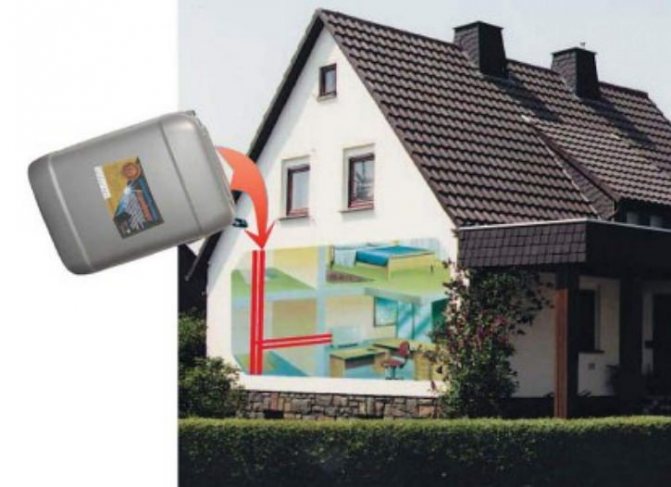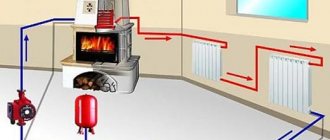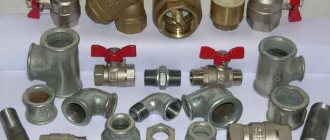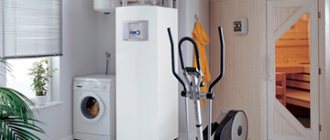Advertising
Double-circuit boiler equipment, solar systems and heat pumps appeared, plastic pipes, taps and connections began to be used as materials. Installation of the system has become simpler, more convenient and more accessible for “non-professionals”, it is easier to configure and repair. The usual solution was the use of "warm floors" based on circulation pipelines.
All these innovations have led to the development of another technical solution: the use of non-freezing fluids - heat carriers in individual heating systems of private houses.
The use of coolants raises many questions, conjectures and disputes. Some stereotypes have already formed a practice that sometimes looks comical. Therefore, in this article, the specialists of the OBNINSKORGSINTEZ company, the "Heat carriers" department, will answer the most common questions.
To use or not to use an antifreeze liquid as a heat carrier?
There is no GOST or standard that provides for the mandatory use of a coolant or prohibits its use. Sometimes there are projects of industrial systems that require the use of "water-glycol solutions", and if you turn to the manufacturers of heating equipment, they also do not have a single common solution - some prohibit altogether, others allow the use of certain brands of coolants. Which solution is correct?
The answer to this question can be obtained taking into account the combination of many factors: this is the model of the equipment, and the type of structure, the mode of its use, the material and insulation of the walls, the type of system, the region of location. But the most important factor is the degree of security of the system in unforeseen, emergency cases.
eddiki
I made myself a heating system for the first time in my life on metal-plastic, there are no leaks in the fittings. The argument in favor of antifreeze was brought by a specialist who started the boiler for me - antifreeze has its drawbacks, but the main thing is to preserve the system in case of any force majeure. According to him, a lot of CO2 died on the water for various reasons last winter. I have propylene glycol, -20, the system works, and I sleep peacefully when I am not at the dacha.
It's no secret that the main task of the coolant is to protect the system from defrosting and damage in case of unforeseen situations. And there are a lot of such situations when a house can remain without heating for a long time:
- long departure of the whole family, when there is no one to heat the house;
- seasonal use of a summer cottage or home;
- Finally, no one is immune from pipeline accidents or prolonged power outages, which have become common in the winter after freezing rains that cut power lines.
In such conditions, the use of an antifreeze liquid is an absolutely justified solution.
Which one to choose, how do they differ?
Serg3515
A lot has been written and rewritten on this topic, but I never saw a clear answer (and preferably from a user with experience). In this regard, if I may, questions. So, after all, what to fill? (what antifreeze liquid). Electric boiler, two-pipe system, metal-plastic pipes.
It can be very difficult for an uninitiated person to understand the abundance of offers and the range of prices.
The key factor in choosing a coolant is its base, i.e. basic chemical raw materials. The following are traditionally used as a basis:
- ethylene glycol is a toxic dihydric alcohol;
- propylene glycol is a non-toxic substance acceptable for use in the food industry.
The second selection criterion is the additives used in the coolant. Distinguish between organic additives (carboxylate) and inorganic. Additives affect the life and quality of the coolant. The coolant with organic additives has a longer service life, and during operation it more reliably protects the system from the effects of corrosion.
The third indicator is how the manufacturers of heating equipment relate to this product, in other words, is it permissible for a particular heat carrier to be used in a system where this type of equipment is used.
Rating of coolants in terms of a set of quality characteristics:
- Heat transfer fluid based on propylene glycol with organic additives and manufacturer approvals. Such a coolant provides the widest range of indicators: environmental friendliness with safety, and service life, and physicochemical indicators, and versatility of use, from kindergarten to food production.
- Heat transfer fluid based on ethylene glycol with organic additives and manufacturer approvals. Such a coolant already has limitations in its application. You can determine its purpose: industrial facilities and systems, reliably isolated from human life.
- Heat transfer fluid based on propylene glycol with conventional inorganic additives. Although such a product has a shorter service life, it is harmless enough for the neighborhood with people and animals.
- Heat transfer fluid based on ethylene glycol with inorganic additives. Poisonous, short service life. Its use is often driven by the need to save money. If the system is well isolated from contact with human life, such a decision is quite logical.
P.S. Glycerin-based heat carrier. Glycerin is the simplest trihydric alcohol, which is a viscous transparent liquid, also used as a food additive. The product has a high density, kinematic and dynamic viscosity. Equipment manufacturers provide indicators several times lower than those present in a glycerin-based coolant. The product does not have operational and physical advantages, although it is quite easy to manufacture, therefore it is inexpensive. European manufacturers of chemical compositions are very negative about the use of glycerin as a base for antifreeze liquids.
Types of antifreeze liquid for heating

Factory antifreeze for heating
Having decided that non-freezing coolants for the heating system should only be of factory quality, you can start choosing a certain composition. It must be adapted to a certain heat supply scheme, and its performance cannot degrade the parameters of the system.
Before pouring non-freezing liquid into the heating system, you need to find out if it will negatively affect the components of the heat supply. To do this, you should read the instructions for use, which must be attached. It is also important to pay attention to the main component of non-freezing liquid for heating boilers. Not only the state of the heat supply components depends on this, but also the operating conditions:
- Ethylene glycol... It is highly toxic. Therefore, it can only be used in closed circuits. Difficulties may arise when pouring this type of freezing liquid into the heating system. In a vaporous state, it is dangerous to human health;
- Propylene glycol... In fact, it is a food additive, therefore it can be used in both open and closed heating systems.Unlike ethylene glycol, the crystallization temperature is at the level of + 80 ° C, which makes it possible to use it for the operation of solid fuel high-temperature boilers. The only drawback is the high cost;
- Glycerol... The most popular type of non-freezing liquid for stove heating. Its performance is slightly lower than that of propylene glycol. However, along with this, the cost of glycerin antifreezes is an order of magnitude less. The disadvantages include high fluidity. This can affect the tightness of the pipelines. The way out is to replace rubber gaskets with paronite ones.
Currently, the use of an antifreeze liquid for a home heating system based on glycerin is the best option.
| Name | Structure | Price, rub / l |
| Warm house -30 ° С | Propylene glycol | 65 |
| Dixis -65 | Glycerol | 75 |
| Comfort technology -65 | Ethylene glycol | 120 |
Manufacturers offer 2 types of non-freezing coolants for the heating system - ready-to-use and concentrate. For large heat supply schemes, it is more profitable to purchase concentrate. However, this complicates the process of filling the system.
When purchasing a ready-to-use liquid, you need to pay attention to the lower critical level of the freezing point. It can be from -25 ° C to -65 ° C.
Dilute with water or not?
The origin of this issue is due to the fact that equipment manufacturers set the same requirements, worrying about the safest and most efficient operation. Buyers are sticking to their cost-saving line. And manufacturers of heat transfer fluids maneuver between the requirements of manufacturers, buyers and sales practices. As always - the truth is somewhere in between.
Manufacturers of non-freezing liquids, in general, offer coolants "-65C" or "-30C" on the market. Firstly, this is due to the formed demand, and secondly, such a coolant is guaranteed not to be frozen at the time of sale.
Equipment manufacturers have their own truth. So, the density of antifreeze liquid marked "-25C", generally recommended by equipment manufacturers for reasons of optimal fluidity, is 1.03 g / cm3, and for liquid "-30C" - 1.04 g / cm3.
The fact that the content of the main substance in the composition of the coolant will be several percent higher is not an “outrageous” deviation, but taking into account the fact that water can be added to the coolant either when feeding the circuit, or if the water is not completely drained from the system after flushing , The "reserve" of concentration is simply necessary.
On the other hand, dilution of the coolant "-30C" to "-25C" - and this value is 3-4% - will not bring tangible savings for the buyer, but at the same time will increase the risk of losing other necessary properties. But in the case when the buyer plans to use the concentrated coolant "-65C" and dilute it already - here the savings can already be up to 20%.
What is the service life, how do you know: when to replace?
The question is quite common.
Andreic
Connoisseurs, clarify the situation: contractors said today that antifreeze has a 5-7 year life. Then it loses its properties, begins to precipitate, as it were, and does not go through the heating system as it should be. Is it true or not?
For heat transfer fluids containing organic (carboxylate) additives, the service life is 10 seasons (10 years), for heat transfer fluids with "ordinary" silicate additives, this period is about 5 years (heating seasons). In order to control the quality, every year, after the end of the heating season, you can carry out a simple procedure - pour a small amount of the coolant into a transparent glass container. The obtained sample is visually inspected for the presence of mechanical and other impurities, color, transparency.If the coolant contains mechanical impurities (crumbs, grains of scale), it can be drained, filtered, flushed out and refilled. If there are traces of chemical changes (flakes, clots), it is necessary to contact a specialist.
In which systems can antifreeze be used?
There are a number of restrictions on the use of antifreeze:
- Non-freezing liquid, regardless of chemical composition, can only be used in a closed circuit. This means that there is constant pressure in the system, the circulation is constantly forced, due to the pump.
- Heat carriers are not used with electrolysis type electric boilers. The electrolysis type is when a coolant is used as an electrical conductor. The electrical conductivity of heat carriers is low, and this will lead to high energy costs.
- Non-freezing liquids must not be used in contact with galvanized surfaces (pipes).
Non-freezing for the heating system of a private house
Before us is a concentrated water antifreeze based on monoethylene glycol. The manufacturer did not forget to add unique additives with which the antifreeze acquired thermal stabilizing, antifoam, antioxidant properties and the ability to protect the system from corrosion.
In addition, the inertness of the liquid to sealing materials has increased significantly. The composition is completely ready to use and does not require dilution with water. However, the manufacturer permits two uses: without dilution and in diluted form.
Among the clear advantages of non-freezing over competitors, I will note a long service life - the liquid can work up to 10 years (!). The product is characterized by high frost resistance, works to remove deposits on the inner surfaces of pipes. Antifreeze does not cause degradation of paronite, rubber, Teflon seals.


The operating temperature range of the non-freezing liquid is simply gorgeous - from -65 to 95 degrees. Crystallization will begin at -66 degrees, boiling - from 111 degrees. Volume - 20 l canister. This anti-freeze for the heating system of a private house has a price of 1.8 tr.
Pros:
- fireproof;
- effective additive package;
- wide range of operating temperatures;
- long service life - 10 years.
There are no downsides.
It is a safe anti-freeze solution based on propylene glycol, which distinguishes it favorably from traditional counterparts based on ethylene glycol in terms of toxicological properties. The composition is intended for use as a working fluid in heat exchange systems in industry and residential buildings. It successfully eliminates "defrosting" when exposed to negative temperatures.
A complex of additives protects equipment from the development of microorganisms, the formation of corrosion. The fluid is compatible with metal-plastic, plastic pipes and seals, works in double-circuit boilers, in open systems, and allows commissioning at low temperatures. Crystallization starts at -31 degrees, freezing at -40 degrees.
Due to the fact that the antifreeze is based on food-grade propylene glycol, it can be safely used even in food processing systems, not to mention residential buildings. The drug provides excellent frost resistance and prevents the destruction of elements of heat exchange systems during freezing, corrosion of cast iron, steel, brass, aluminum and solder. Plus, it prevents the accumulation of scale and, in principle, prevents its formation. Volume - 20 kg canister. Price - from 1.9 tr.
Pros:
- eliminates the destruction of the system;
- fireproof;
- favorable cost;
- 100% final quality control;
- full set of additives.
Minuses:
- not suitable for the harsh Yakut winters.
Thermotrust antifreeze is used in the form of aqueous solutions or in its original form.It can be safely launched into autonomous heating systems of residential buildings to prevent defrosting against a background of low temperatures. The additive package is optimally balanced and provides protection against microorganisms, corrosion, scale.
The composition is inert to sealing materials, contains heat stabilizing, antioxidant, antifoam components. Does not destroy cast iron, steel, copper, aluminum, brass and solder, compatible with metal-plastic and plastic pipes.
The basis of the liquid is monoethylene glycol, it is homogeneous, red in color, does not contain mechanical impurities. In regions with a temperate climate, it can be diluted with water, in the regions of the Far North it is used in its pure form. The crystallization temperature is -66 degrees, the boiling point is 111 degrees. The price of a canister of 20 l - from 1.8 tr.
Pros:
- high frost resistance;
- blocks the degradation of elements of heat exchange systems during freezing;
- works in the range -65 - 90 degrees;
- diluted with plain tap water;
- made on the basis of quality raw materials;
- service life is 5 years.
Minuses:
- does not work with galvanized systems and electrode type boilers.
Antifreeze is environmentally friendly and ready to use. The base is propylene glycol (green). The composition can be diluted with plain tap water up to -20 degrees. If you have a double-circuit or heating boiler, dilution is a must.
It is better to use non-freezing liquid on propylene glycol where there are increased requirements for environmental safety (heat pumps, double-circuit boilers), but it is excellent friends with any heating systems.
The liquid is characterized by a good temperature range from -30 to 104 degrees. The composition includes a special set of additives. This gives protection against corrosion, foaming, scale. Antifreeze is not aggressive to metal-plastic and plastic, paronite, rubber, flax. With such characteristics, the possibility of leaks is excluded. The price of a canister for 20 liters is from 1.6 tr.
Pros:
- environmental friendliness;
- explosion and fire safety;
- works in any systems;
- excellent set of additives;
Minuses:
- does not work with galvanized systems.
This is another safe antifreeze in our rating. The composition is based on high quality propylene glycol, corrosion inhibitors, demineralized water, dyes. It successfully works in heating and air conditioning systems for residential buildings.
It is a homogeneous chemical liquid without mechanical impurities of green color. Crystallization begins at a temperature of minus 31 degrees, the boiling point is plus 107 degrees.
We offer you to familiarize yourself with Pumps for increasing the water pressure in the water supply system
Thanks to the latest formula, the composition prevents corrosion of copper, cast iron, brass, steel and solder. There is no aggressiveness in relation to seals, plastic and metal-plastic pipes.
In addition, anti-freeze is recommended for use by the All-Russian Research Institute of Corrosion. Inhibitors and antibacterial additives work for an extended period. Antifreeze is completely ready for use.
Pros:
- environmentally friendly;
- good working range;
- excellent corrosion protection;
- does not affect sanitary rubber, gaskets, plastic and metal pipes.
Minuses:
- does not work with galvanized surfaces;
- not suitable for the regions of the Far North.
How to determine the required temperature, or is -30C a lot or a little?
Application practice shows that the temperature in a room that has not been heated for a long time and the ambient temperature are always different. The room will always be warmer - 10 degrees or more. Even if "outside the window" is minus 40, and the room is frozen to minus 30, the coolant will not turn into ice and, accordingly, will not burst pipes and radiators.In order for antifreeze marked -30C to freeze and damage the heating system, the temperature (in the house) must be below -50C, which in reality is quite difficult to imagine.
Rash98
For three seasons I have been using propylene glycol as antifreeze in a natural circulation system. Everything works perfectly. The batteries heat up after just 10 minutes. I use propylene glycol not concentrated, but diluted to the freezing point minus 30 degrees. S. Zalit once three years ago.
On the other hand, non-freezing liquids with a temperature of minus 10, 15 and even 20C should not be used for a number of reasons:
- Even in the central regions of Russia in winter, the temperature drops below the indicated values. In such conditions, hardly anyone will want to buy a product that has turned into a "snow porridge", despite the fact that after thawing, it will fully return its properties.
- At the slightest dilution (which is very likely, especially in double-circuit boilers, or after flushing the system), the coolant without a small temperature reserve will lose its necessary properties.
When is antifreeze used in heating?
The main task of the coolant is to take heat from the boiler heater and carry it through pipes and radiators, and warming the space, return to the boiler unit. That is, for heating, antifreeze liquid also performs a cooling function together with a heating one. Such a cycle is only possible if the heating system is active.
If the heating equipment does not work, then the coolant does not circulate inside the circuit. As a result, the process of lowering the temperature of the liquid in the heating system starts at a rate that depends on weather conditions and the degree of thermal insulation of the room. In winter, when the boiler and pumps are not working, the water temperature drops to the level of crystallization and acquires the state of ice.
When freezing, the volume of water increases, so the ice simply breaks the radiators, assemblies and sections of the batteries. To prevent this situation in a system with irregular functioning, it is necessary to use a low-freezing liquid for heating boilers.
Therefore, if you live in the house from time to time, in the country, or you often have interruptions in the supply of electricity, then it is better to use antifreeze as a coolant. Otherwise, you will have to drain the water every time you leave your home for more than a day, and refill it upon returning.
When there was water in the system, everything was fine, the coolant was poured in - all connections flowed.
Arnau
It's time to decide how to fill the heating system in a country house: distilled water or antifreeze.
Against antifreeze, the main reason is that it corrodes the connections, leaks are possible and you need to frequently change the components.
Indeed, non-freezing liquids are more fluid than water. And the fluidity increases with increasing temperature. They do not contain chemical compounds that, forming calcium deposits, can clog micro-gaps. Even if the micro-gaps are clogged with something, the coolant additives "clean" the clogged formations and restore the flow. Therefore, it is necessary to pay more attention to the assembly of joints in the system where it is planned to use antifreeze. And, as mentioned earlier, before starting, it is imperative to carry out commissioning, including pressure testing of the system.
How to fill the system correctly?
In order for the heating system to work properly, it is not enough to purchase a good antifreeze; you also need to study the technology of how to fill an anti-freeze into the circuit.
The nuances of pouring an anti-freeze liquid are as follows:
- If antifreeze was used in the system before, then a complete flushing of the equipment is imperative, since mixing two types of anti-freeze can give an unpredictable chemical reaction.
- In a closed circuit, the pour point must be below all other equipment.The system is filled with a circulation pump. In this case, it is important that the pressure in the pipeline is no more than 3 atm.
- For an open circuit, the use of low-freezing compositions is highly undesirable. In this case, the probability of foaming is high. The system is filled with antifreeze through an expansion tank at the very top of the wiring.
We suggest that you familiarize yourself with How to remove a heating battery
If you intend to fill a heating system with natural circulation, then antifreeze must be poured into the expansion tank through the flow hose.
There are two things to watch out for here:
- Bleeding of air (it is necessary to check all the valves that are available, in the case when float valves are used that release air automatically, then you just need to observe the filling);
- So that the container is always filled, since in the opposite case an air lock will form and the liquid will need to be drained on a new one.
If ordinary taps are installed in the system, then the filling should be carried out by two people - one makes sure that the container is constantly filled, the other monitors the taps. If automatic taps are installed in the system, one person can fill the system with liquid.
In the case when a forced circulation installation is used, the coolant must be supplied under pressure using a pump with a bottom water intake. A durable hose must be connected to it and firmly fixed at the joints, after which the hose is lowered into a container with antifreeze and the pump starts.
But there are also some nuances here:
- Due to the fact that the container is emptied quickly enough due to the operation of the pump, it is imperative to monitor how it is filled in order to prevent the appearance of an air lock.
- Monitor the pressure in the system (it should not exceed 2-3 atmospheres), and stop the pump in time.
- Before pumping in antifreeze, it is recommended to fill the system with water a day in advance to check its tightness. Detecting leaks after filling the system with antifreeze is highly undesirable, due to its high toxicity and the likelihood of entering living quarters. In addition, draining the liquid itself, for troubleshooting, is quite problematic.
In the event that water was previously used in the heating system, then it must be remembered that water has more expansion properties compared to antifreezes. And before using them, it is required to replace all seals at the joints to prevent leaks.
In addition, it must be remembered that it is impossible to completely drain all the water from the system and because of this there is a possibility of dilution of the antifreeze. In order to prevent loss of density, it is necessary to mix an antifreeze solution with concentrates in a ratio of about 1: 1.
During operation, there will be a need for self-topping antifreeze. Because of what it is necessary to buy it with a margin of about 15-20% more than the calculated volume of the system.


















